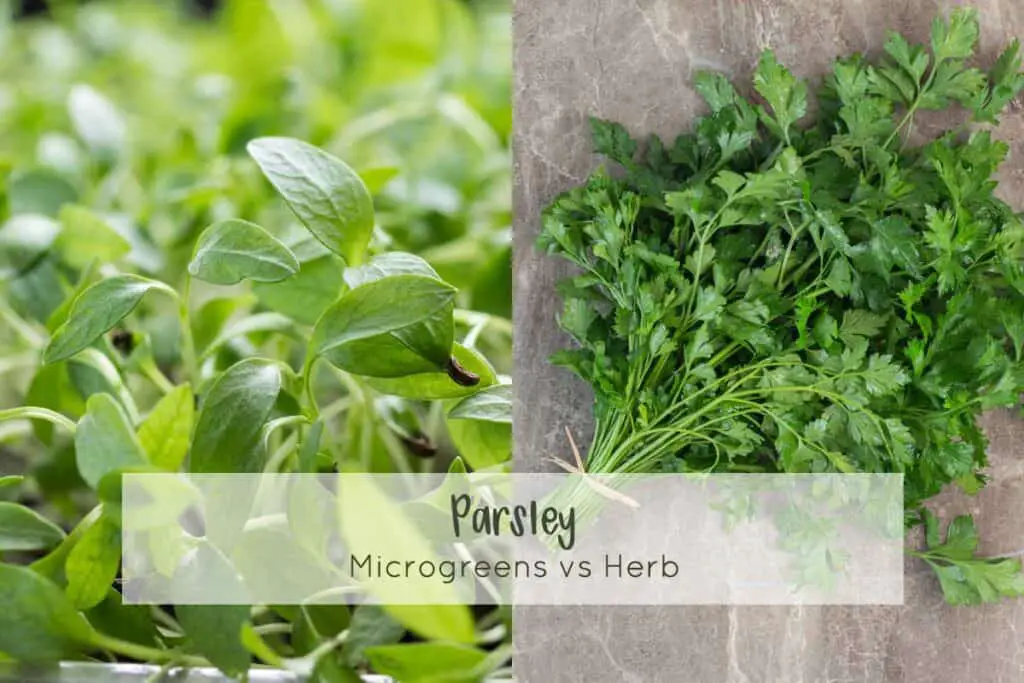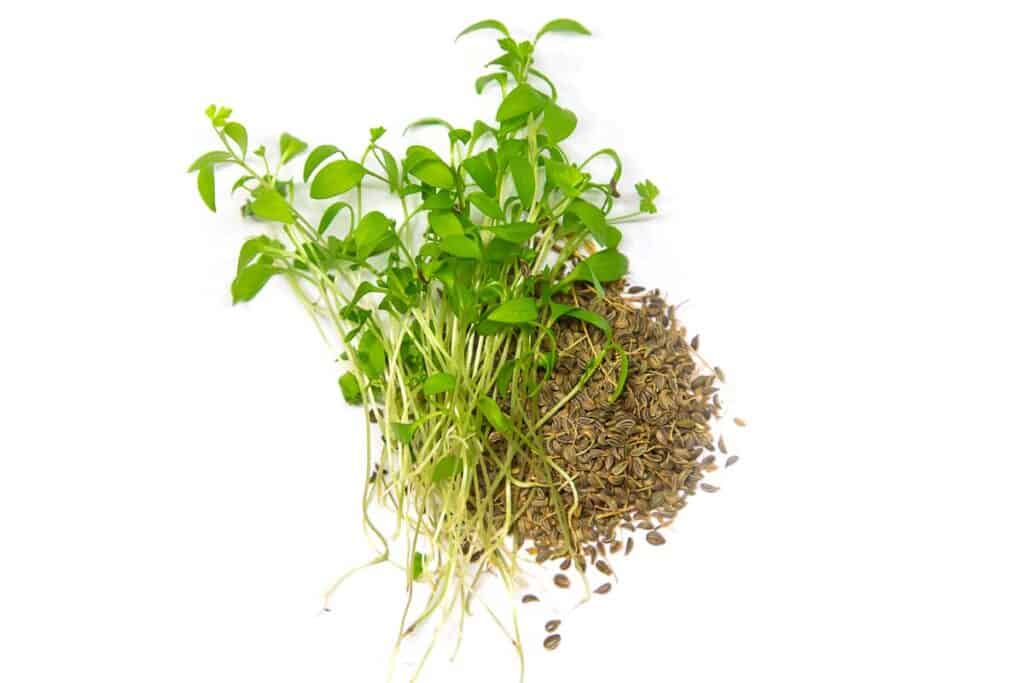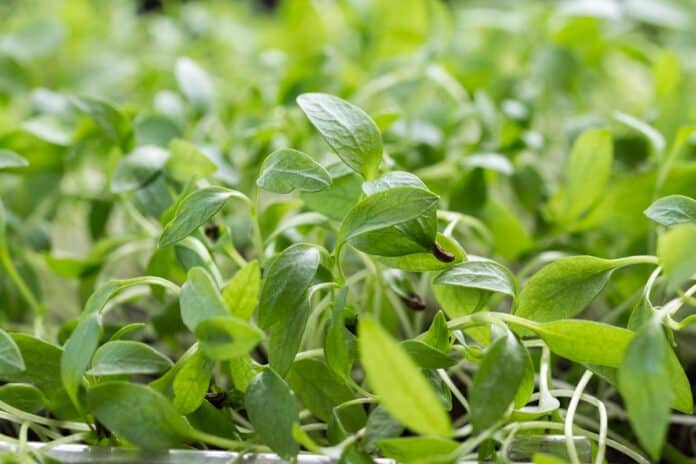Do you also love parsley and want to enjoy this savory herb all year round? Parsley microgreens are one of the more easy varieties to grow. They are also versatile, and give flavor and taste to so many dishes! This must be the best combination!
WHAT ARE PARSLEY MICROGREENS?
Parsley microgreens are leafy, green, and tasty small edible plants that you harvest after three weeks! They are popular in our household as we use them on top of grilled meat and vegetables, in salads, and mixed in our favorite pesto!
Parsley is easy to grow, even though it requires some patience before the seeds germinate. It takes around 20 days before they are ready for harvest. The result is a deep green mini plant with pointy leaves. If you want to grow feathered leaves, it may take even longer.
If you compare growing parsley microgreens to full-grown parsley that takes 2-3 months to mature, they are still a fast-growing microgreen! And the results are rewarding!
| Growing period | 18-20+ days |
| Flavor | Mild parsley flavor |
| Growing difficulty | Easy |
| Buy seeds | Parsley seeds from True Leaf Market Parsley seeds from Amazon |
DESCRIPTION
Parsley is one of the more popular herbs to use as garnish and seasoning. It’s native to the Mediterranean region but widely used in various cuisines in Europe, North America, and other parts of the world.

You can enjoy the parsley as an add-in or base in salads, sandwiches, pesto, on grilled meat and veggies, boiled potatoes, only to mention a few!
Parsley is mainly known as a herb in an outdoor garden, but with the introduction of microgreens, you can easily cultivate them at home. The benefits are that you will have your crop ready for harvest much quicker and still get tasty and highly nutritious herbs!
As a full-grown herb, the parsley has much longer stems with feathery leaves, whereas they are mature as microgreens when they are two inches long, and the first true leaves have developed. You will have the same fresh and grassy taste, though a bit milder than the mature herb.
Parsley microgreens are grown from the same seeds you will use when planting the full-grown herb. The difference lies in how you plant them. The density level is higher, and you treat them differently during the germination process. Outdoor gardening is often seasonal, but when you grow microgreens, you don’t have to worry about this as they can be grown indoors all year round!
GENERAL NUTRITION & BENEFITS
Parsley microgreens are not short of nutrition! They are not only tasty, but they are also a great source of vitamins A, C and K, minerals, and antioxidants. They are also known to hold fiber, potassium, magnesium, and calcium.
HOW TO GROW PARSLEY MICROGREENS
Parsley microgreens are easy to grow, but you need a bit of patience. The overall growing period is longer than most microgreens, and you will have to patiently wait for your seeds to germinate. After around 20 days, you will have fresh, beautiful, and tasty microgreens! You can check them out at around day 18 as from this day, you may be able to get your scissors or knife out to cut them.
| Growing timeline (estimated) | |
|---|---|
| Presoak | 4-5 hours |
| Preferred medium | Soil or coconut coir |
| Avg. seed weight (10/20 tray) | 1 oz |
| Germination period (blackout) | Day 1-7 |
| Growth time (sunlight) | Day 8-17 |
| Harvest | Day 18-20+ |
Parsley is an easy microgreen to grow, but it will take longer than many other varieties. The seeds can be slow to germinate and to speed up the process they benefit from being pre-soaked. Place them in water half a day before you start with the seedling.

The best medium to use is either organic potting soil or coconut coir. For growing at home, using coconut coir is an excellent choice. It’s organic, holds water very well, and importantly; is odorless and bacteria-free! It will help microgreens from developing mold and other diseases.
If you want to learn more about coconut coir, we have a complete article on the subject here!
Place a layer of soil or coconut coir in your container of choice and flatten it out with your hands. Consider filling up about 2/3 in height. Spread the seeds evenly across the tray. A good reference is to use 1 oz for a 10/20 sized tray.
Water the seeds, give them a good mist without soaking. Place the container in a dark space or cover them up for a week. It’s what we refer to as the blackout period. During this initial phase, the seeds will start to germinate.
Around day 7, bring your container out in the light, and you will see the magic happen! Your parsley microgreens will turn into green beautiful mini veggies!
Parsley microgreens continuously need water to grow, so remember to give them a good mist, twice a day. It goes for both the blackout phase (germination) and the light phase (growing). A good reference is to check in on them once in the morning and once in the evening. If the growing medium is still moist, it can be enough with only watering once a day.
The parsley microgreens are ready for harvest when they are a bit more than an inch in height and have grown. The stems have grown tall, and you can see the leaves have emerged. To harvest, you can use a sharp knife, or scissors and cut the stems close to the soil level.
CULINARY GUIDING
Parsley microgreens are one of those varieties that are great to grow because you can use them for so many different dishes. Parsley is excellent in pesto, in soups, in salads, and well, the list can go on. You can more or less put chopped parsley microgreens on everything! Or even mix them in your next smoothie. It’s one of those microgreens that just go with most dishes!
When it is time for BBQ, bring out your parsley microgreens, and spread them over your grilled vegetables and potatoes. Here are some inspiring ways to use parsley microgreens in your cooking:
- Smoothie with microgeen parsley
- Fresh and Simple Parsley Salad
- Spring herb mushroom risotto with parsley as garnish
Enjoy your parsley microgreens!


